A new initiative leveraging the innovative design of the Monmouth Scientific Class 2 Biological Safety Cabinet aims to enhance the propagation and conservation of rare plant species. By maintaining a sterile environment, this technology minimizes contamination risks, thereby ensuring both staff safety and the integrity of sensitive plant tissues.
Ensuring Safety and Efficiency in Plant Propagation
The implementation of biological safety cabinets is a significant advancement for laboratories focused on plant research. These cabinets create an inward airflow that protects personnel from exposure to biological materials. This feature is crucial, especially when handling delicate specimens that require meticulous care.
The sterile airflow in these cabinets safeguards the plant samples from contamination, promoting healthier growth conditions. This is particularly important for tissue culture and micropropagation processes, where even minor contamination can compromise the entire research effort. The result has been an increase in successful propagation rates, enabling researchers to achieve their conservation goals more effectively.
Advancements in Conservation Practices
The use of the Monmouth Scientific Class 2 Biological Safety Cabinet has transformed how conservationists approach their work. By filtering exhaust air, the cabinets not only protect the staff but also contribute to a safer laboratory environment. This comprehensive protection allows researchers to focus on their tasks without the constant concern of contamination.
Moreover, the reliability of these cabinets has led to more repeatable workflows. As a consequence, conservation efforts have accelerated, allowing organizations to make significant strides in preserving biodiversity. With the ability to work confidently in a fully protected environment, staff can enhance their productivity while ensuring the well-being of both personnel and plant material.
The integration of advanced technological solutions like the biological safety cabinet illustrates a commitment to improving conservation methodologies. As challenges in plant propagation continue to evolve, these innovations will play a critical role in supporting research efforts aimed at safeguarding rare and endangered species.







